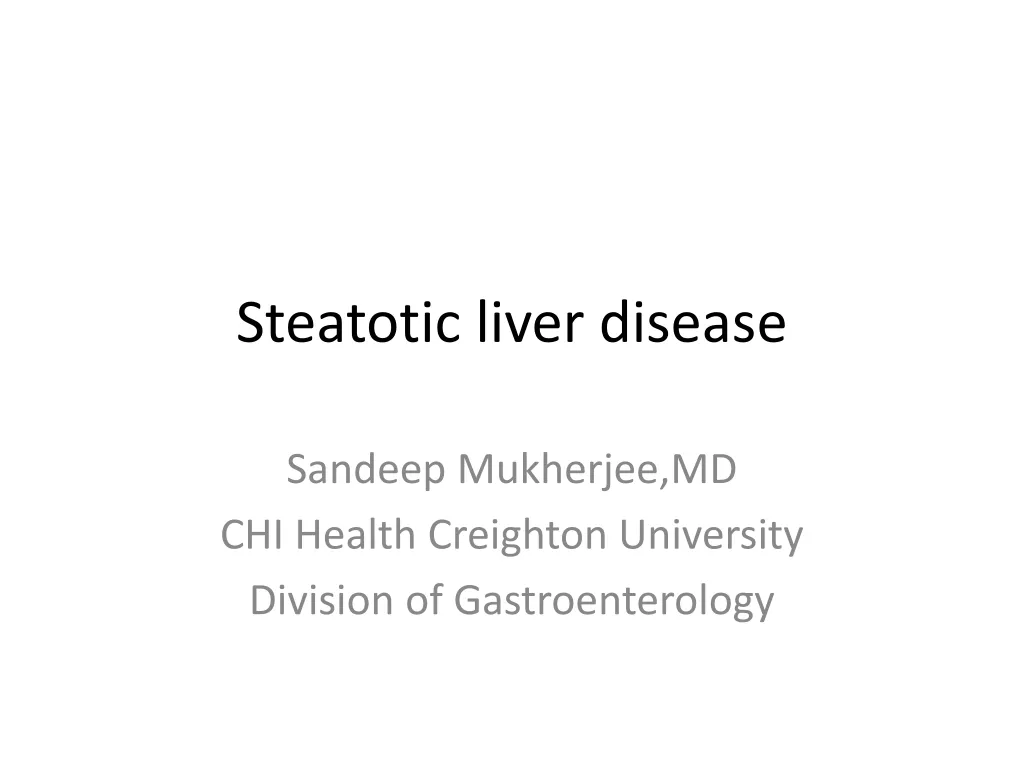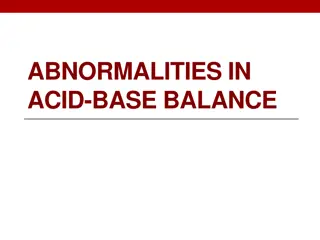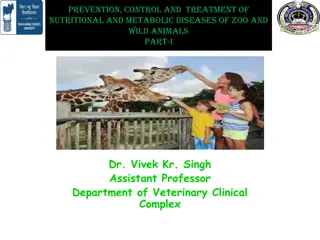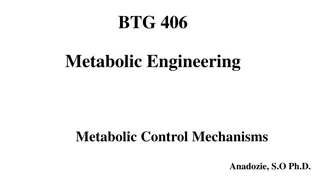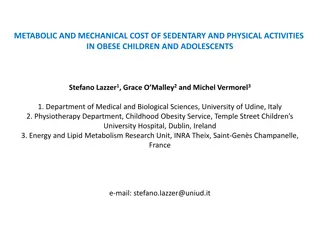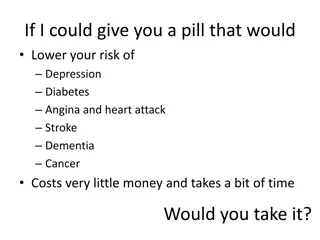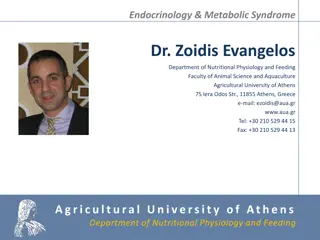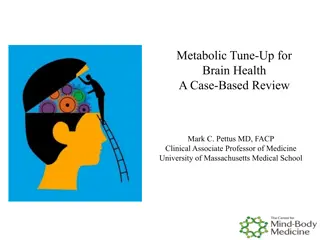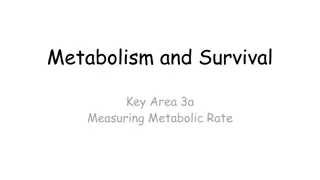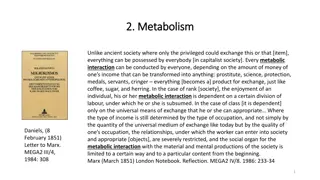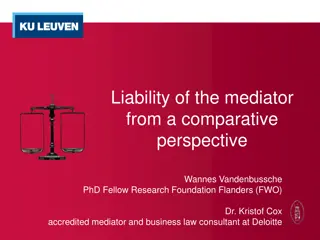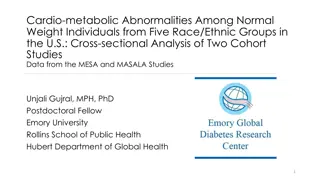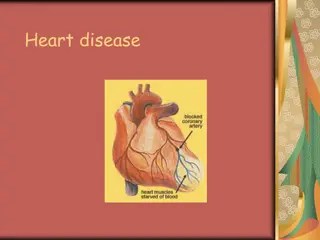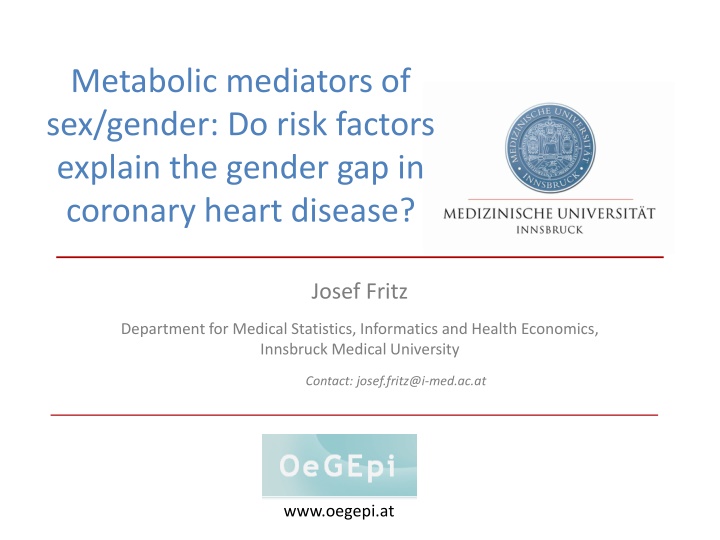
Gender Disparities in Coronary Heart Disease Risk Factors
Explore the relationship between sex/gender, risk factors, and coronary heart disease mortality through research conducted at Innsbruck Medical University. Discover the impact of metabolic mediators on the gender gap in heart disease and the influences of various factors on CHD outcomes.
Download Presentation

Please find below an Image/Link to download the presentation.
The content on the website is provided AS IS for your information and personal use only. It may not be sold, licensed, or shared on other websites without obtaining consent from the author. If you encounter any issues during the download, it is possible that the publisher has removed the file from their server.
You are allowed to download the files provided on this website for personal or commercial use, subject to the condition that they are used lawfully. All files are the property of their respective owners.
The content on the website is provided AS IS for your information and personal use only. It may not be sold, licensed, or shared on other websites without obtaining consent from the author.
E N D
Presentation Transcript
Metabolic mediators of sex/gender: Do risk factors explain the gender gap in coronary heart disease? Josef Fritz Department for Medical Statistics, Informatics and Health Economics, Innsbruck Medical University Contact: josef.fritz@i-med.ac.at www.oegepi.at
Situation Age Unmeasured confounding Year of examination Systolic blood pressure Total cholesterol Glucose Smoking status Explained by risk factors (indirect effect) Sex/Gender Death from CHD Unexplained by risk factors (direct effect) Sex/Gender influences CHD risk factors which in turn affect the outcome (death from CHD). Estimate effects of the different paths. 2
CHD as death cause Source: Nichols et al. Cardiovascular disease in Europe 2014: epidemiological update. European Heart Journal (2014) 3
CHD and risk factors (1) Fixed Modifiable Age Sex Genetics Blood pressure Type 2 diabetes Smoking Lipids (cholesterol, triglycerides) Body weight Prevention is possible via control of modifiable risk factors. 4
CHD and risk factors (2) Ten-year risk of fatal cardiovascular disease in populations at low cardiovascular disease risk. Source: Conroy et al. Estimation of ten-year risk of fatal cardiovascular disease in Europe: the SCORE project. European Heart Journal (2003) 5
Sex and age differences in major CHD risk factors Source: Ulmer et al. Why Eve is not Adam: prospective follow-up in 149650 women and men of cholesterol and other risk factors related to cardiovascular and all-cause mortality. Journal of Women s Health (2004) 6
Research question (1) In general, men have a higher CHD mortality risk than women, especially at younger ages. Men have also other risk factor profiles (TC, blood pressure, glucose, smoking) than women. Age Unmeasured confounding Year of examination Systolic blood pressure Total cholesterol Glucose Smoking status Explained by risk factors (indirect effect) Sex/Gender Death from CHD Unexplained by risk factors (direct effect) 7
Research question (2) Can the difference in CHD mortality risk (ICD-10 code I20-I25) between sexes be explained by different risk factor profiles and if yes, how much can be explained? Method: Mediation analysis stratified for age groups <50, 50-64, 65-74, and 75 years based on a Cox regression model for survival data. New mediation approach according to Lange et al. which further allows breakdown of indirect effect into single components. Lange T, Rasmussen M, Thygesen LC. Assessing natural direct and indirect effects through multiple pathways. Am J Epidemiol. 2014 Feb 15;179(4):513-8. 8
Results (1) Effect decomposition 1.8 HR = 4.65 1.6 1.4 Blood pressure HR = 3.09 1.2 Glucose 1.0 Indirect effect ln(HR) Cholesterol 0.8 HR = 1.74 0.6 Smoking HR = 1.40 0.4 Direct effect (not explained by risk factors) 0.2 0.0 -0.2 Age <50 Age 50-64 Age 65-74 Age 75+ 9
Results (2) Results of mediation analysis: Total, direct, and indirect effects of sex/gender on CHD mortality by age groups, adjusted for age at baseline and year of examination 75 years <50 years 50-64 years 65-74 years Contribution to total effect (%) Contribution to total effect (%) Contribution to total effect (%) Contribution to total effect (%) Effects (males versus females) Hazard Ratio Hazard Ratio Hazard Ratio Hazard Ratio 95% CI 95% CI 95% CI 95% CI Total effect 4.65 3.52 to 6.14 100.0% 3.09 2.72 to 3.52 100.0% 1.74 1.56 to 1.93 100.0% 1.40 1.24 to 1.57 100.0% Direct effect* 2.48 1.73 to 3.54 59.1% 2.72 2.37 to 3.12 88.5% 1.67 1.49 to 1.89 93.4% 1.40 1.22 to 1.60 100.5% Indirect effect, combined 1.87 1.63 to 2.16 40.9% 1.14 1.10 to 1.18 11.5% 1.04 1.01 to 1.07 6.6% 1.00 0.93 to 1.07 -0.5% Indirect effect, through systolic blood pressure 1.40 1.26 to 1.55 21.7% 1.00 1.00 to 1.00 0.0% 0.99 0.98 to 0.99 -2.6% 0.98 0.97 to 1.00 -3.2% Indirect effect, through cholesterol 1.17 1.11 to 1.23 10.0% 0.97 0.95 to 0.98 -3.1% 0.98 0.94 to 1.01 -4.6% 1.00 0.97 to 1.04 1.3% Indirect effect, through glucose 1.08 1.03 to 1.13 5.0% 1.04 1.03 to 1.05 3.7% 1.00 1.00 to 1.01 0.7% 0.98 0.98 to 0.99 -4.9% Indirect effect, through smoking 1.07 1.03 to 1.10 4.2% 1.13 1.09 to 1.17 10.8% 1.07 1.03 to 1.12 13.1% 1.02 0.97 to 1.08 6.2% *Effect of sex/gender not mediated by the four analyzed risk factors. Calculated according to the Delta-method. On ln HR scale. 10
Take home messages Premature mortality from CHD is substantially lower in women. We estimated the contribution of major risk factors to this gender difference. BP and TC explain one third of the survival benefit in pre- menopausal women. This is in line with the oestrogen hypothesis. In older persons, risk factors contribute much less to the mortality difference. 11

